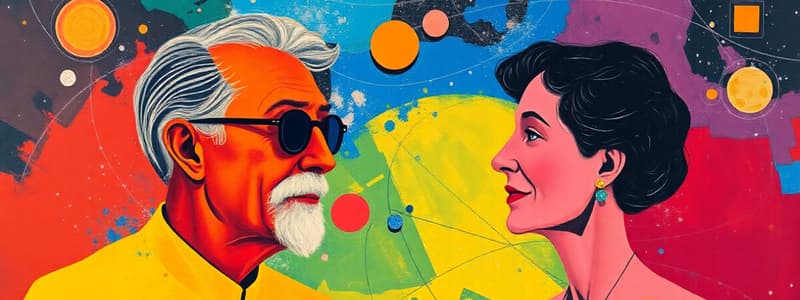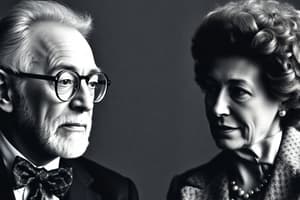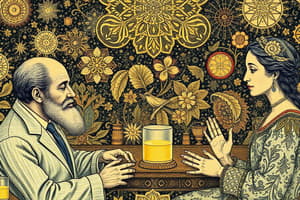Podcast
Questions and Answers
Fred Hoyle's steady state theory posits which of the following about the universe?
Fred Hoyle's steady state theory posits which of the following about the universe?
- The universe maintains a constant average density through continuous creation of new matter. (correct)
- The universe's density increases over time due to the accumulation of dark matter and energy.
- The universe's density decreases over time as matter disperses into the expanding void.
- The universe oscillates between periods of expansion and contraction, maintaining a stable overall density.
What was Katherine Johnson's primary role in NASA's space missions?
What was Katherine Johnson's primary role in NASA's space missions?
- Manually calculating and verifying trajectory analysis for manned spaceflights. (correct)
- Conducting astronaut training and simulations for zero-gravity environments.
- Developing advanced computer algorithms for real-time flight control systems.
- Designing the physical structure of the spacecraft and launch vehicles.
Irene Uchida's research primarily focused on which area of medical genetics?
Irene Uchida's research primarily focused on which area of medical genetics?
- Investigating how chromosomal differences affect various genetic conditions, including congenital abnormalities. (correct)
- Developing gene therapies to correct chromosomal abnormalities in utero.
- Examining the relationship between gene expression and environmental factors.
- Investigating the ethical implications of genetic screening and prenatal diagnosis.
What was Yvonne Brill's major contribution to space technology?
What was Yvonne Brill's major contribution to space technology?
What is Abdus Salam best known for in the field of physics?
What is Abdus Salam best known for in the field of physics?
Which of the following best describes Fred Hoyle's view on the origin of life?
Which of the following best describes Fred Hoyle's view on the origin of life?
How did Katherine Johnson contribute to the Apollo 11 Moon mission?
How did Katherine Johnson contribute to the Apollo 11 Moon mission?
What specific chromosomal abnormality did Irene Uchida investigate in relation to Down syndrome?
What specific chromosomal abnormality did Irene Uchida investigate in relation to Down syndrome?
What was the key implication of Vera Rubin's observation that stars in the outer regions of spiral galaxies orbit as fast as those closer to the center?
What was the key implication of Vera Rubin's observation that stars in the outer regions of spiral galaxies orbit as fast as those closer to the center?
What is the significance of the Higgs field in the context of particle physics, according to Peter Higgs' theory?
What is the significance of the Higgs field in the context of particle physics, according to Peter Higgs' theory?
How did Eric Kandel's research on sea slugs contribute to the understanding of human memory?
How did Eric Kandel's research on sea slugs contribute to the understanding of human memory?
What was the direct consequence of Mario Molina's and Sherwood Rowland's research on chlorofluorocarbons (CFCs)?
What was the direct consequence of Mario Molina's and Sherwood Rowland's research on chlorofluorocarbons (CFCs)?
How did Lap-Chee Tsui's work on cystic fibrosis contribute to advancements in treatment?
How did Lap-Chee Tsui's work on cystic fibrosis contribute to advancements in treatment?
What was Mae Carol Jemison's primary role during her space shuttle mission aboard the Endeavour?
What was Mae Carol Jemison's primary role during her space shuttle mission aboard the Endeavour?
What is the underlying principle of chirped pulse amplification (CPA), developed by Donna Strickland and Gérard Mourou?
What is the underlying principle of chirped pulse amplification (CPA), developed by Donna Strickland and Gérard Mourou?
What is the primary significance of telomeres and telomerase, the focus of Carol Greider's research, in the context of cancer?
What is the primary significance of telomeres and telomerase, the focus of Carol Greider's research, in the context of cancer?
What fundamental concept did the electroweak theory, proposed by one of the Nobel laureates, aim to unify?
What fundamental concept did the electroweak theory, proposed by one of the Nobel laureates, aim to unify?
How did Vera Rubin's findings challenge the prevailing understanding of galactic dynamics at the time?
How did Vera Rubin's findings challenge the prevailing understanding of galactic dynamics at the time?
What specific prediction stemming from Peter Higgs’s theory was later confirmed through experiments at CERN?
What specific prediction stemming from Peter Higgs’s theory was later confirmed through experiments at CERN?
What role do synapses play in memory and learning, according to Eric Kandel's Nobel Prize-winning research?
What role do synapses play in memory and learning, according to Eric Kandel's Nobel Prize-winning research?
What was the key finding of Mario Molina and Sherwood Rowland concerning CFCs and their impact on the environment?
What was the key finding of Mario Molina and Sherwood Rowland concerning CFCs and their impact on the environment?
What is the primary physiological consequence of the genetic defect identified by Lap-Chee Tsui in cystic fibrosis patients?
What is the primary physiological consequence of the genetic defect identified by Lap-Chee Tsui in cystic fibrosis patients?
Besides laser eye surgery, what is another practical application of the chirped pulse amplification (CPA) technique pioneered by Donna Strickland and Gérard Mourou?
Besides laser eye surgery, what is another practical application of the chirped pulse amplification (CPA) technique pioneered by Donna Strickland and Gérard Mourou?
Flashcards
Fred Hoyle
Fred Hoyle
British astrophysicist known for work on the origin of elements in stars and the steady state theory.
Katherine Johnson
Katherine Johnson
American mathematician who calculated trajectories for space missions like Alan Shepard's and Apollo 11.
Irene Uchida
Irene Uchida
Canadian medical geneticist who investigated chromosome differences in genetic conditions like Down syndrome.
Yvonne Brill
Yvonne Brill
Signup and view all the flashcards
Steady State Theory
Steady State Theory
Signup and view all the flashcards
Origin of Elements in Stars
Origin of Elements in Stars
Signup and view all the flashcards
Down Syndrome
Down Syndrome
Signup and view all the flashcards
Stationary Orbit
Stationary Orbit
Signup and view all the flashcards
Abdus Salam's Theory
Abdus Salam's Theory
Signup and view all the flashcards
Vera Rubin's Discovery
Vera Rubin's Discovery
Signup and view all the flashcards
Higgs Field
Higgs Field
Signup and view all the flashcards
Higgs Boson
Higgs Boson
Signup and view all the flashcards
Eric Kandel's Research
Eric Kandel's Research
Signup and view all the flashcards
Mario Molina's Work
Mario Molina's Work
Signup and view all the flashcards
Lap-Chee Tsui's Finding
Lap-Chee Tsui's Finding
Signup and view all the flashcards
Mae Carol Jemison
Mae Carol Jemison
Signup and view all the flashcards
Chirped Pulse Amplification (CPA)
Chirped Pulse Amplification (CPA)
Signup and view all the flashcards
Donna Strickland's Achievement
Donna Strickland's Achievement
Signup and view all the flashcards
Telomeres
Telomeres
Signup and view all the flashcards
Telomerase
Telomerase
Signup and view all the flashcards
Greider's Cancer Research
Greider's Cancer Research
Signup and view all the flashcards
Evidence for Dark Matter
Evidence for Dark Matter
Signup and view all the flashcards
Memory Consolidation
Memory Consolidation
Signup and view all the flashcards
Study Notes
- Science is increasingly diverse and globally connected, fostering collaboration and interdisciplinary approaches to expand human knowledge.
Fred Hoyle (1915–2001)
- A British astrophysicist who worked on the origin of elements in stars.
- Postulated that nuclear reactions within large stars create most chemical elements step-by-step.
- He was a proponent of the steady state theory, which suggests the Universe maintains constant average density through continuous creation of new matter as it expands.
- He coined the term "Big Bang" disparagingly during a radio talk about the rival theory.
- His steady state theory was largely discredited in the 1960s.
- He later focused on the presence of organic molecules in comets, believing they brought life to Earth.
Katherine Johnson (1918–)
- An award-winning American mathematician who was key in calculating trajectories for space missions, including Alan Shepard's.
- She began at NACA in 1953, manually performing calculations for engineers.
- She aided in planning the launch site and flight path for the Apollo 11 Moon mission in 1969.
- She later worked on the US space shuttle program and retired from NASA in 1986.
Irene Uchida (1917–2013)
- A Canadian medical geneticist who initiated work on how genes and chromosomes affect health.
- She investigated chromosome differences in genetic conditions and congenital abnormalities.
- These conditions were congenital heart disease and Down syndrome, where individuals have an extra chromosome.
- She examined the effects of X-rays on chromosomes.
Yvonne Brill (1924–2013)
- Born near Winnipeg, Canada, and started with Douglas Aircraft in 1945.
- She invented a propulsion system to maintain unmanned spacecraft in stationary orbit.
- She also worked on thrusters for weather satellites, rocket designs for US Moon missions, and the Mars observer.
- While at NASA from 1981-1983, she worked on a rocket engine for the space shuttle.
Abdus Salam (1926–1996)
- Born in Pakistan, he studied mathematics and physics at the University of Cambridge, UK.
- He proposed the electroweak theory, explaining the weak interaction between subatomic particles and its potential unification with the electromagnetic force.
- His theory posited messenger particles for the weak interaction, with different messengers exchanged in different instances.
- His theories were proven correct at CERN in 1973.
- He was jointly awarded the Nobel Prize in Physics with Sheldon Lee Glashow and Steven Weinberg in 1979.
Vera Rubin (1928–2016)
- During the 1970s, she discovered that stars in the outer spiral galaxy orbit as fast as those closer to the center.
- This contradicted Newton's laws of gravity and indicated galaxies have a halo of invisible matter affecting outer stars.
- In 1970, Rubin confirmed this in the Andromeda Galaxy.
- By 1985, she had examined 60 spiral galaxies and found it was a general phenomenon.
- Rubin's work convinced astronomers of the existence of dark matter.
- She received the National Medal of Science in 1993.
Peter Higgs (1929–)
- Born in Newcastle, England, studied physics at King's College London.
- He began at the University of Edinburgh in 1960.
- He is best known for his theory explaining the origin of the mass of elementary particles.
- According to this theory, particles gain mass by interacting with the Higgs field that permeates space.
- He predicted the Higgs field would produce the Higgs boson particle.
- The search for the Higgs boson led to the Large Hadron Collider (LHC) at CERN.
- Scientists discovered a particle with the predicted Higgs boson characteristics in 2012.
- Received the Nobel Prize in Physics in 2013 with François Englert for their 1964 work.
Eric Kandel (1929–)
- He fled Vienna with his family to the US due to anti-Semitism.
- He studied medicine at New York University and received his degree in 1956.
- Interested in the cellular basis of behavior.
- He was awarded the Nobel Prize in Physiology or Medicine in 2000 for his work on synapses in memory and learning.
- He investigated sea slugs to clarify short- and long-term memory processes.
- He showed that the memory processes are equally applicable in humans.
Mario J. Molina (1943–)
- Born in Mexico City, he studied chemical engineering.
- In 1974, he and Sherwood Rowland demonstrated that CFCs from aerosols, foams, and refrigerants destroy the ozone layer.
- This work led to banning/limiting CFCs and earned Molina and Rowland the 1995 Nobel Prize in Chemistry.
Lap-Chee Tsui (1950–)
- A Canadian medical geneticist born in Shanghai, moved to Canada in 1977.
- He jointly discovered the faulty gene responsible for cystic fibrosis which causes thick mucus.
- Identifying the gene paved the way for treatments based on gene correction or replacement.
Mae Carol Jemison (1956–)
- The first African American woman to travel in space, she went into orbit in the space shuttle Endeavour in 1992.
- Jemison graduated from medical school in 1981 and served as a medical officer with the Peace Corps in West Africa.
- In 1985, she applied to the US space agency, and in 1987, became one of 15 candidates selected from over 2,000 applicants to train as an astronaut.
- She was the science mission specialist on the space shuttle and a coinvestigator of two bone cell research experiments performed there.
Donna Strickland (1959–)
- A Canadian optical physicist who paved the way for the shortest and most intense laser pulses.
- In 1985, she and Gérard Mourou developed chirped pulse amplification (CPA).
- She and Mourou were jointly awarded the Nobel Prize in Physics in 2018 for CPA..
- Strickland became an associate professor at the University of Waterloo in 1997, leading the ultrafast laser research team.
- CPA has uses in laser eye surgery and some cancer therapies.
Carol Greider (1961–)
- An American molecular biologist.
- She has researched telomeres and the enzyme telomerase.
- Telomeres are DNA segments at the ends of chromosomes, important for cell life span.
- In 2009, she, Elizabeth Blackburn, and Jack W. Szostak were awarded the Nobel Prize in Physiology or Medicine.
- Her work found that inhibiting telomerase in cancer cells slows tumor growth, making it a potential anticancer drug development.
Studying That Suits You
Use AI to generate personalized quizzes and flashcards to suit your learning preferences.
Description
Explore the contributions of Fred Hoyle and Katherine Johnson to astrophysics. Hoyle worked on the origin of elements in stars and proposed the steady state theory. Johnson calculated trajectories for space missions, including Alan Shepard's.





